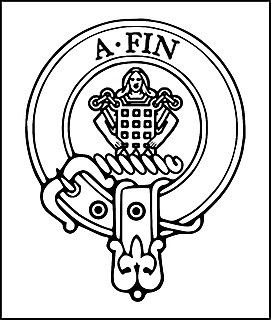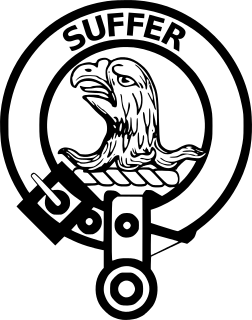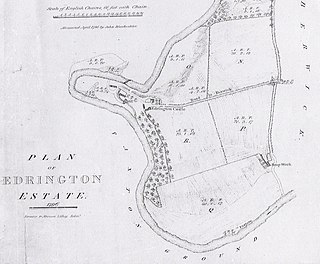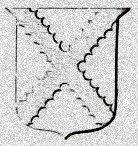Related Research Articles

The Declaration of Arbroath is the name usually given to a letter, dated 6 April 1320 at Arbroath, written by Scottish barons and addressed to Pope John XXII. It constituted King Robert I's response to his excommunication for disobeying the pope's demand in 1317 for a truce in the First War of Scottish Independence. The letter asserted the antiquity of the independence of the Kingdom of Scotland, denouncing English attempts to subjugate it.
Dunsmore is a name with a separate origin in Scotland and England.
The Lord Chancellor of Scotland was a Great Officer of State in the Kingdom of Scotland.

Ragman Rolls are the collection of instruments by which the nobility and gentry of Scotland subscribed allegiance to King Edward I of England, during the time between the Conference of Norham in May 1291 and the final award in favour of Balliol in November 1292; and again in 1296. Of the former of these records two copies were preserved in the Chapter House at Westminster Abbey, and it has been printed by Thomas Rymer. Another copy, preserved originally in the Tower of London, is now also in the National Archives. The latter record, containing the various acts of homage and fealty extorted by Edward from John Balliol and others in the course of his progress through Scotland in the summer of 1296 and in August at the parliament of Berwick, was published by Prynne from the copy in the Tower and now in the National Archives. Both records were printed by the Bannatyne Club in 1834.
The personal name Duncan can be found in Scotland’s oldest records in its Gaelic form Dunchad/Donchadh/Donachie/Donnchadh and other spelling variants.

Clan Cochrane is a Scottish clan of the Scottish Lowlands.

Clan Ogilvy/Ogilvie is a Scottish Highland clan from Angus, Scotland. Gillebride, Earl of Angus, received a barony from King William the Lion in 1163 and bestowed the lands of Ogilvy upon his son Gilbert. In 1491, King James IV elevated Sir James Ogilvy as Lord Ogilvy of Airlie. Saint John Ogilvie was a Scottish Jesuit martyr who was hanged for his faith in 1615 and who was canonised in the Roman Catholic Church. In 1639, the 7th Lord Ogilvy of Airlie was made the 1st Earl of Airlie by King Charles I for his support of the Crown in the Wars of the Three Kingdoms. The present Chief of Clan Ogilvie is David Ogilvy, 13th Earl of Airlie, who served as Lord Chamberlain to Queen Elizabeth II. His brother Angus Ogilvy married Queen Elizabeth II's first cousin Princess Alexandra of Kent.

Clan Haldane is a Lowland Scottish clan.

The Abbot of Arbroath or Abbot of Aberbrothok was the head of the Tironensian Benedictine monastic community of Arbroath Abbey, Angus, Scotland, founded under the patronage of King William of Scotland from Kelso Abbey and dedicated to St Thomas of Canterbury, Thomas Becket. The abbot, John Gedy, was granted the mitre on 26 June 1396. Arbroath Abbey became the wealthiest and most powerful abbey in later medieval Scotland.

Clan Jardine is a Scottish clan of the Scottish Lowlands.
Clan Straiton, also called Straton or Stratton, is a Lowland Scottish clan. The clan does not currently have a chief therefore it is considered an Armigerous clan.

Edrington is a medieval estate occupying the lower part of Mordington parish in Berwickshire, Scottish Borders, Scotland, five miles (8.0 km) west of Berwick-upon-Tweed. From probably the 14th century, if not earlier, a castle occupied the steep hill above the mill of the same name on the Whiteadder Water. The castle ruin is still marked on today's Ordnance Survey maps, and still appears in locality references in The Berwickshire News. The principal farm of the estate is Edrington Mains.

Mordington is an agricultural parish in the extreme south-east of Berwickshire in the Scottish Borders region. It is five miles from Berwick-upon-Tweed and borders Northumberland to the east, and south, Foulden to the west, and Lamberton to the north. The parish is bisected by the A6105 Berwick to Duns road. The lower part of the parish is covered by the Edrington estate. It is possibly the warmest parish in Scotland; the annual hours of sunshine are said to be almost as high as at Dunbar, which records the most hours in Scotland.

Nicholas de Balmyle, also called Nicholas of St Andrews, was a Scottish administrator and prelate in the late 13th century and early 14th century. A graduate of an unknown university, he served his earliest years as a clergyman at St Andrews, moving on to hold churches in Lothian as well as deputising to two archdeacons of Lothian.
Bernard was a Tironensian abbot, administrator and bishop active in late 13th- and early 14th-century Scotland, during the First War of Scottish Independence. He first appears in the records already established as Abbot of Kilwinning in 1296, disappearing for a decade before re-emerging as Chancellor of Scotland then Abbot of Arbroath.

Clan Maxton is a Scottish clan. The clan does not have a chief recognised by the Lord Lyon King of Arms therefore the clan has no standing under Scots Law.

Sir David de Brechin was a Scottish knight who fought on both sides during the Wars of Scottish Independence.

Clan Russell is a Scottish armigerous clan, with claimed origins in Normandy. It has ancestral ties to the English Dukes of Bedford, and has numerous descendants in Great Britain and America.
Domhnall mac Cailein or Donald Campbell was a 13th-14th century Scottish nobleman and the Sheriff of Wigtown.

Clan Abercromby is a Lowland Scottish clan. The clan does not currently have a chief, it is considered an armigerous clan.
References
- "Ragman Rolls". Rampant Scotland. Retrieved 1 April 2007.
- Duncan, A. A. M. (2004). "Bernard (d. 1330/31)". Oxford Dictionary of National Biography. Oxford University Press. Retrieved 1 April 2007.
- Hay, George (1899). History of Arbroath to the Present Time. Arbroath, Scotland: T. Buncle. OCLC 9183509